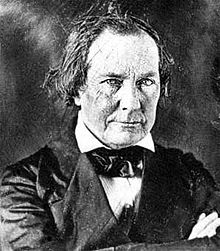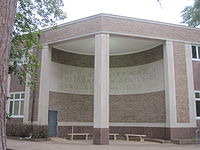- Mirabeau B. Lamar
-
Mirabeau Buonaparte Lamar 
2nd President of the Republic of Texas In office
December 19, 1838 – December 13, 1841Preceded by Sam Houston Succeeded by Sam Houston Personal details Born August 16, 1798
near Louisville, GeorgiaDied December 19, 1859 (aged 61)
near Richmond, TexasResting place Morton Cemetery,
Richmond, Texas
29°35′09″N 95°45′48″W / 29.5858°N 95.7633°WNationality American, Texan Spouse(s) Tabitha Jordan Lamar (died 1830)
Henrietta MaffittRelations Lucius Q. C. Lamar (brother)
Lucius Q. C. Lamar II (nephew)Children Rebecca Ann Lamar (born c. 1827)
Loretto Evalina LamarMirabeau Lamar monument at Stephen F. Austin State University in Nacogdoches, Texas, reads: "The cultivated mind is the guardian genius of democracy."
Mirabeau Buonaparte Lamar (1798–1859) was a Texas politician, diplomat and soldier who was a leading Texas political figure during the Texas Republic era. He was the second President of the Republic of Texas, after David G. Burnet (1836 as ad-interim president) and Sam Houston.
Contents
Early years
Lamar grew up at Fairfield, his father's plantation near Milledgeville, Georgia.[1] As a child, he loved to read and educated himself through books. Although he was accepted to Princeton University, Lamar chose not to attend. Instead, he worked as a merchant and then ran a newspaper, but both of those enterprises failed.[2]
In 1823, Lamar's family connections helped him to gain a position as the private secretary to Georgia Governor George M. Troup. In this position, Lamar issued press releases and toured the country giving speeches on behalf of the governor. On one of his trips, he met Tabatha Jordan, whom he married in 1826.[2]
When Troup lost his reelection bid in 1828 Lamar established a newspaper in Columbus, Georgia, the Columbus Enquirer.[3] This venture was much more successful than his previous business attempts. The year after its establishment Lamar's wife died, and he withdrew his name from consideration for reelection to the Georgia Senate, in which he had served one term, and began to study law. He was admitted to the bar in 1833 and ran an unsuccessful campaign for a seat in the U.S. Congress.[2]
He was also a Master Mason, and a member of Harmony Lodge No. 6 in Galveston, Texas.
Texas revolution
Lamar's brother Lucius committed suicide in 1834, and a grief-stricken Lamar began traveling to escape his memories. In the summer of 1835 he ended up in Texas and decided to stay.[2] He joined Sam Houston's army in spring 1836 and distinguished himself with bravery at the Battle of San Jacinto.[2] On the eve of the battle, Lamar made a courageous rescue of two surrounded Texans in a move that drew a salute from the Mexican lines. He was promoted to colonel and was the commander of the cavalry during the battle the following day.
His actions led to an appointment as the Secretary of War in the interim Texian government. In 1836, he was elected vice-president of the Republic of Texas under Houston.[2]
President of Texas
“ The cultivated mind is the guardian genius of democracy. ” —Mirabeau B. Lamar[4]
Lamar was the unanimous choice to replace Houston as president in 1838, and was inaugurated on December 1, 1838.[2] It was said that when Houston was giving his farewell speech, Houston was dressed like George Washington. When he went on the stage he noticed that Lamar was eager to give his speech.[citation needed] Houston lengthened his farewell address to 3 hours, "which so unnerved Lamar that he was unable to read his inaugural speech." Instead, it was given by his aide, Algernon P. Thompson.[2] In his first formal address to the Texas Congress several weeks later, Lamar urged that the Cherokee and Comanche tribes be driven from their lands in Texas, even if the tribes must be destroyed. He also proposed to create a national bank and to secure a loan from either the United States or Europe. Finally, he opposed annexation to the United States and wished to entice European countries to recognize the Republic of Texas.[5]
His first actions were against the Indian tribes. In 1839 his troops drove the Cherokee tribes from Texas. The battle resulted in the death of Houston's friend Chief Bowles, leaving Houston angry at Lamar. A similar campaign was fought against the Comanche. Although many lives were lost, the Comanches could not be forced from the area.[5] Lamar believed that it was necessary to bring about the “total extinction" of the Indian tribes.[6]
Lamar appointed a commission to select a permanent site for the capital of the Republic. After two months of debate, they recommended the small town of Waterloo along the Colorado River. The town was renamed Austin, and by October 1839 all of the records and employees were transferred from Houston to Austin.[5] That same year, he founded the Texas State Library (presently known as the Texas State Library and Archives Commission).[5]
During his administration, Lamar sent three separate agents to Mexico to enact a peace settlement. All failed. Nonetheless, Lamar succeeded in gaining official recognition for his country from the United Kingdom, France, and Belgium.[7] Despite several attempts to secure a loan from these and other countries, Lamar was unsuccessful. To fill the treasury, he authorized issuance of a large amount of Republic of Texas paper money, known as Redbacks. The paper money was virtually worthless. Spending doubled during Lamar's term, and combined with the worthless currency, caused financial difficulties for the government.[5][7]
Lamar believed that the Rio Grande River was the western boundary of Texas, and wanted to send an expedition to New Mexico to establish trade, and convince the residents to join the Republic. The Texas Congress refused to fund the expedition in 1839 and 1840. In June 1841, Lamar took $89,000 from the treasury and sent an expedition on his own. The members were arrested when they reached Santa Fe, and told they would soon be released. Instead, they were marched to Mexico City, and many died during their enforced march.[7]
Lamar has been called "the Father of Texas Education." During his administration, he convinced the legislature to set aside 3 leagues of land for each county to equip schools. He also allotted 50 leagues of land for the support of two universities, later Texas A&M University and the University of Texas. Although nothing was implemented during his term, these actions led to the foundation for a statewide public school system.[5]
One of his quotes sums up his views "Cultivated mind is the guardian genius of democracy and, while guided and controlled by virtue, the noblest attribute of man. It is the only dictator that freemen acknowledge and the only security that freemen desire."
Later years
Houston became president again when Lamar's term completed in late 1841. Lamar returned to service in the army, and distinguished himself at the Battle of Monterrey during the Mexican-American War. In late 1847, he became a post commander at Laredo, but disliked the job as he wished to see more action. While in Laredo, he married again.[8]
He represented Eagle Pass in the Texas State Legislature for several years after Texas was annexed to the United States. In 1857, President James Buchanan appointed Lamar to be the Minister to Nicaragua. Lamar served in Managua for twenty months before returning to Texas in October 1859 because of poor health. He died of a heart attack at his Richmond plantation on December 19, 1859.[8]
Legacy
Lamar County, in northeast Texas, and Lamar, a small unincorporated community in Aransas County on the Texas Gulf Coast, are both named for Mirabeau Lamar. Lamar Boulevard, a major thoroughfare in Austin, also carries his name, as do many streets around Texas.
Lamar University in Beaumont was named after Mirabeau B. Lamar in 1932. It is currently the largest educational facility to be named after the former Texas President with an enrollment of over 14,000 students. The Campus features a statue to commemorate Mirabeau B. Lamar's life. The defunct Lamar University System named all of its member institutions after Mirabeau B. Lamar these include: Lamar State College - Port Arthur in Port Arthur, Lamar State College in Orange, and Lamar Institute of Technology in Beaumont. Lamar High School in Houston, Lamar High School in Arlington, Lamar Consolidated High School in Rosenberg; also Lamar Middle School in Austin, Lamar Middle School in Dallas, Lamar Middle School in Irving; elementary schools in Amarillo, Corpus Christi, El Paso and San Antonio, and The Woodlands; as well as numerous other K-12 schools throughout Texas.
Other Media
His name is used as the honorary of the military academy in Preston Jones' play The Oldest Living Graduate, which is part of A Texas Trilogy
References
- ^ http://www.tshaonline.org/handbook/online/articles/LL/fla15.html
- ^ a b c d e f g h Hendrickson (1995), p. 35.
- ^ Prospectus for the Columbus Enquirer, 1828 - Texas State Library, tsl.state.tx.us; retrieved September 2008
- ^ Inscribed on the Paul L. Boynton Building at Stephen F. Austin State University in Nacogdoches, Texas
- ^ a b c d e f Hendrickson (1995), p. 37.
- ^ Anderson, Gary C. The Conquest of Texas: Ethnic Cleansing in the Promised Land 1820-1875, 2005, pg. 174, ISBN 0806136987
- ^ a b c Hendrickson (1995), p. 38.
- ^ a b Hendrickson (1995), p. 39.
Further reading
- Ramsay, Jack C. (1984), Thunder Beyond the Brazos: Mirabeau B. Lamar, a Biography, Eakin Press, ISBN 9780890154625
- Siegel, Stanley (1977), The Poet President of Texas: The Life of Mirabeau B. Lamar, President of the Republic of Texas, Jenkins Pub Co, ISBN 9780836301533
External links
- Mirabeau B. Lamar New Georgia Encyclopedia Article
- Mirabeau Buonaparte Lamar from the Handbook of Texas Online
- Sketch of Mirabeau Lamar from A pictorial history of Texas, from the earliest visits of European adventurers, to A.D. 1879, hosted by the Portal to Texas History.
- U.S. & Texas Jurisdiction Conflict, June 3, 1839 From Texas Tides
- Mirabeau B. Lamar at Find a Grave
Political offices Preceded by
Lorenzo de Zavala
ad interimVice President of the Republic of Texas
1836–1838Succeeded by
David G. BurnetPreceded by
Sam Houston
first termPresident of the Republic of Texas
1838–1842Succeeded by
Sam Houston
second termDiplomatic posts Preceded by
John H. WheelerUnited States Minister to Nicaragua
February 8, 1858–May 20, 1859Succeeded by
Alexander DmitryVacant Title last held bySolon BorlandUnited States Minister to Costa Rica
September 14, 1858–May 20, 1859Presidents of the Republic of Texas 

Vice Presidents of the Republic of Texas 
Lamar University Academics College of Business • College of Arts and Sciences • College of Education and Human Development • College of Fine Arts and Communication • College of Engineering • TALH • College of Graduate StudiesAthletics Southland Conference • Lamar Cardinals and Lady Cardinals • Big Red • Football • Basketball (M) • Basketball (W) • Baseball • Golf • Track • Volleyball
Facilities: Provost Umphrey Stadium • Montagne Center • Vincent-Beck Stadium • McDonald Gym
People: Larry Tidwell • Billy Tubbs • Jim Gilligan • Pat Knight • Ray Woodard • Cardinal AthletesCampus Setzer Student Center • Mary and John Gray Library • The Quad • Sheila Umphrey Center • Cardinal Village • Dishman Art Museum • Spindletop-Gladys City Boomtown MuseumStudent Life Miscellaneous List of Lamar University alumni • History of Lamar UniversityCategories:- 1798 births
- 1859 deaths
- Georgia (U.S. state) State Senators
- Members of the Texas House of Representatives
- Presidents of the Republic of Texas
- Vice Presidents of the Republic of Texas
- People of the Texas Revolution
- People from Columbus, Georgia
- American diplomats
- American newspaper founders
- American people of French descent
Wikimedia Foundation. 2010.

